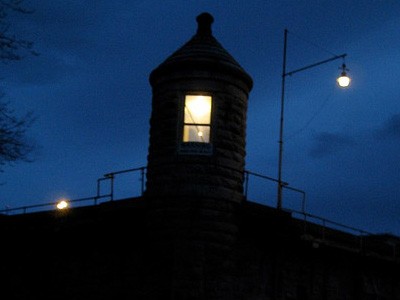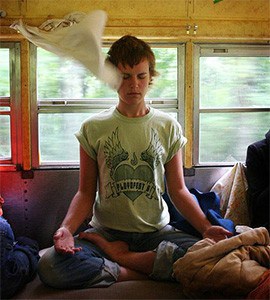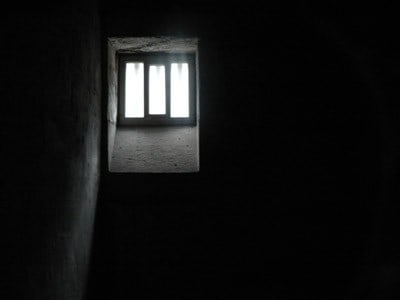A prison visit following the killing of an incarcerated person

On September 4, 2003, Venerable Thubten Chodron and I traveled down Interstate 5 to Salem, Oregon, to visit the Buddhist group in Oregon State Prison (OSP). Our liaison to the prison, Karuna Thompson, one of the prison chaplains, informed us that one incarcerated person had murdered another just a day or so before and that the men had all been in lock-down ever since. She informed us that activities such as our visit were just restored to the men. So, we arrived at OSP wondering how this terrible event had affected the men. The waiting room was packed with family members who went one at a time through the metal detector to get a short visit. One teen girl had worn jeans with many zippers and could not get through and was denied her visit.
Once again, Father Jacobsen the Jesuit priest chaplain escorted us in. We passed through two security points, with ID checks, hand stamps etc. and then climbed two flights of grey concrete steps. We passed the prison library and entered the chapel. A few men greeted us and set up a small altar and arranged the pews into an L shape. Then the others trickled in: some grey haired, one Asian, one African heritage, young, tall, short, hefty and slender. We greeted, gathered quietly together and then Venerable led these eight men in prostrations. Most of them said they had never prostrated before. Most of the men went to the floor, honoring the Buddha, Dharma and Sangha in their blue prison jeans and shirts stamped with the word “inmate” on their backs. I don’t think I will ever forget the sight of this group of men engaged in this simple, but profound act of humility and purification.
After a short meditation, Venerable opened up to questions. The range was far and wide: several men talked about how much the Dharma means to them; how it evens out their responses to the daily provocations they experience at OSP. One described that in dangerous or tense times armed guards with masks are posted on the prison rooftops with guns leveled at them as they have time in the yard. Venerable asked them how the murder was affecting them.
Of course, there had been no time in the yard for several days—and it was hot, in the 90s. They were grateful just to be out of their hot cells. One man said that he had played chess sometimes with the victim. He said the man wanted to improve, but, “just didn’t have the talent to do it.” Everyone was quiet. Suddenly I could see the humanity of the murder victim. He was a man, he played chess, he wanted better. As the Dalai Lama always reminds us, we all want happiness. As we prepared to leave the chapel, I glanced down at the pew I had been sitting in. A swastika was carved in the wood. Prison. It’s a hard hard place to live; full of blatant hate, fear and even murder. And yet these eight men showed up to study Dharma and to purify their karma by prostrating and meditating. They have a Buddhist community. And hope.
Zopa Herron
Karma Zopa began to focus on the Dharma in 1993 through Kagyu Changchub Chuling in Portland, Oregon. She was a mediator and adjunct professor teaching Conflict Resolution. From 1994 onward, she attended at least 2 Buddhist retreats per year. Reading widely in the Dharma, she met Venerable Thubten Chodron in 1994 at Cloud Mountain Retreat Center and has followed her ever since. In 1999, Zopa took Refuge and the 5 precepts from Geshe Kalsang Damdul and from Lama Michael Conklin, receiving the precept name, Karma Zopa Hlamo. In 2000, she took Refuge precepts with Ven Chodron and received the Bodhisattva vows the next year. For several years, as Sravasti Abbey was established, she served as co-chair of Friends of Sravasti Abbey. Zopa has been fortunate to hear teachings from His Holiness the Dalai Lama, Geshe Lhundup Sopa, Lama Zopa Rinpoche, Geshe Jampa Tegchok, Khensur Wangdak, Venerable Thubten Chodron, Yangsi Rinpoche, Geshe Kalsang Damdul, Dagmo Kusho and others. From 1975-2008, she engaged in social services in Portland in a number of roles: as a lawyer for people with low incomes, an instructor in law and conflict resolution, a family mediator, a cross-cultural consultant with Tools for Diversity and a coach for executive directors of non-profits. In 2008, Zopa moved to Sravasti Abbey for a six-month trial living period and she has remained ever since, to serve the Dharma. Shortly thereafter, she began using her refuge name, Karma Zopa. In May 24, 2009, Zopa took the 8 anagarika precepts for life, as a lay person offering service in the Abbey office, kitchen, gardens and buildings. In March 2013, Zopa joined KCC at Ser Cho Osel Ling for a one year retreat. She is now in Portland, exploring how to best support the Dharma, with plans to return to Sravasti for a time.


